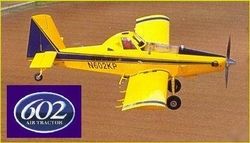Says Pilot Made Series Of Mayday Calls Before Impact
 It's
sad enough when we must report on the loss of a pilot's life. It's
even harder to bear when it appears the pilot in question saw his
end coming... Ed.
It's
sad enough when we must report on the loss of a pilot's life. It's
even harder to bear when it appears the pilot in question saw his
end coming... Ed.
NTSB Identification: DEN08GA076
14 CFR Public Use
Accident occurred Tuesday, April 15, 2008 in Fort Carson, CO
Aircraft: Air Tractor AT-602, registration: N602AA
Injuries: 1 Fatal.
This is preliminary information, subject to change, and may
contain errors. Any errors in this report will be corrected when
the final report has been completed.
On April 15, 2008, approximately 1810 mountain daylight time, an
Air Tractor AT-602 single-engine air tanker airplane, N602AA, was destroyed when it impacted terrain
while maneuvering near Fort Carson, Colorado. The
commercial pilot, who was the sole occupant, sustained fatal
injuries. The airplane was operated by the Department of Defense,
Fort Carson, Colorado, for public use firefighting missions, and
registered to Aero-Applicators, Inc., Sterling, Colorado. Visual
meteorological conditions prevailed, and a company flight plan was
filed. The flight originated from a private airstrip in Sterling,
Colorado.
According to the registered owner, they were contacted by the
Colorado State Forest Service Pueblo dispatch and requested to
assist with aerial fire suppression efforts at the 9,800-acre
Training Area 25 wildfire near Fort Carson, Colorado. The airplanes
departed a private airstrip near Sterling, Colorado, at 1700, with
full fuel tanks and 500 gallons of water and Class A foam.
The United States Forest Service (USFS) air-to-ground contact,
who was located near the intended drop area, stated that he was in
radio contact with the two airplanes when they arrived to the
wildfire area. The USFS contact informed the accident airplane
pilot the intended drop location and expectations. The intended
drop area was a line of pine trees located to the north of a gravel
road and the existing wildfire, and the contact wanted the trees
protected in case the wildfire crossed the road. Prior to the live
drop, the accident pilot performed a dry run, and the second
airplane flew approximately 500 feet overhead as a spotter. After
completing the dry run, the airplane circled around to the south
and east to set up for the live drop, which was an east to west
flight pattern. The airplane flew to the west over the top of a
tall pine tree, and the pilot released the load approximately 500
feet west of the intended drop location. The load was dropped on
top of the ground contact and his vehicle.
 After a second or two, the contact
overhead the pilot reported a series of maydays and "I'm going
down." The contact looked up to the west and observed the
airplane's right wing impact the terrain. The contact stated the
wind was from the southwest and gusting to 30 to 40 knots.
After a second or two, the contact
overhead the pilot reported a series of maydays and "I'm going
down." The contact looked up to the west and observed the
airplane's right wing impact the terrain. The contact stated the
wind was from the southwest and gusting to 30 to 40 knots.
The accident site was located on a grass covered hill adjacent
to highway 115 at an elevation of approximately 6,600 feet mean sea
level. The airplane came to rest in an upright position on a
measured magnetic heading of 340 degrees. Examination of the
wreckage showed that the right wing was crushed aft and bent up,
and the fuselage was crushed to the right. The main landing gear
struts and wheel assemblies were separated. The left wing was bent
forward and the aft fuselage attach fitting was separated. The
right horizontal stabilizer was bent aft and up, and the left
horizontal stabilizer was bent forward. The 5-blade propeller
assembly was separated from the propeller shaft, and one blade was
separated from the hub.
 ANN's Daily Aero-Term (04.26.24): DETRESFA (Distress Phrase)
ANN's Daily Aero-Term (04.26.24): DETRESFA (Distress Phrase) Aero-News: Quote of the Day (04.26.24)
Aero-News: Quote of the Day (04.26.24) ANN's Daily Aero-Term (04.27.24): Direct
ANN's Daily Aero-Term (04.27.24): Direct ANN's Daily Aero-Linx (04.27.24)
ANN's Daily Aero-Linx (04.27.24) Aero-News: Quote of the Day (04.27.24)
Aero-News: Quote of the Day (04.27.24)




